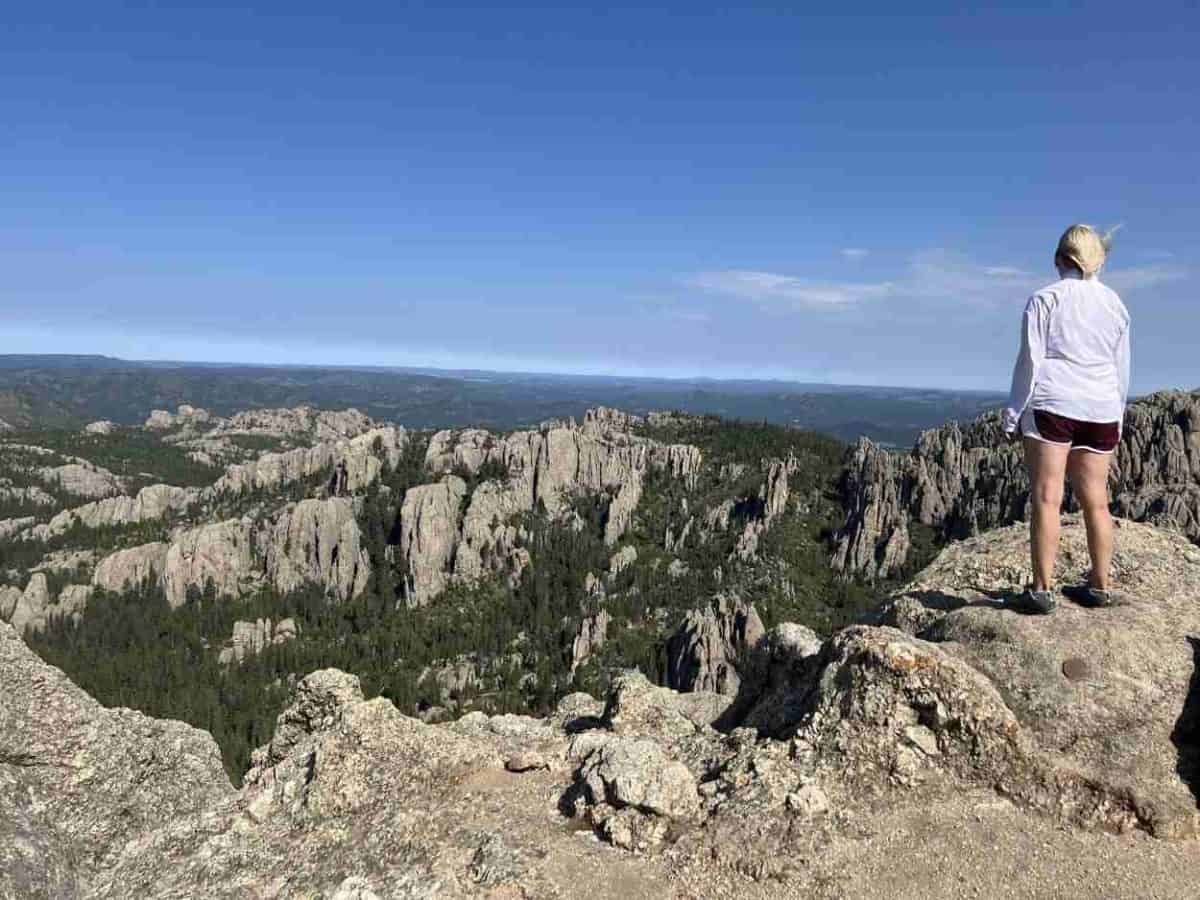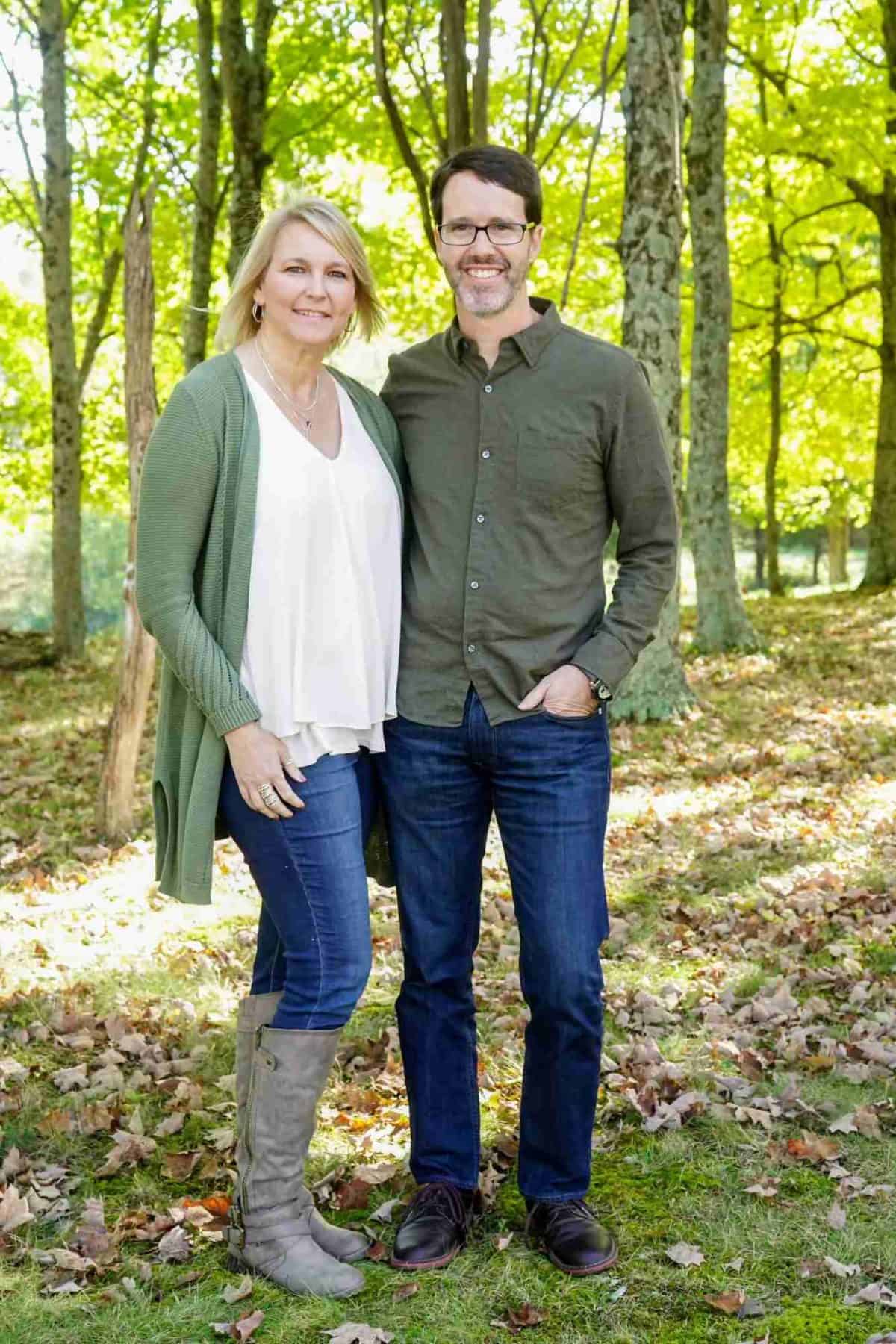Many travelers flock to South Dakota to marvel at Mount Rushmore National Memorial and Badlands National Park. Both are fantastic. If you love scenic drives, rewarding hikes, and unique wildlife, add Custer State Park to your South Dakota plans. The state park steals the spotlight from the national park sites. We cover everything you need to know to plan your Custer State Park adventure in the Black Hills of South Dakota.
Disclosure: We thank Kampgrounds of America for generously hosting our stay. All opinions are our own. This article may contain affiliate links from which we earn a small commission at no additional cost.
Interesting Facts
- Custer State Park is South Dakota’s oldest and largest state park.
- The park was named for Lieutenant Colonel George Armstrong Custer, whose 1874 expedition led to the famous Black Hills Gold Rush.
- It was initially a state forest before becoming a state park.
- The park spans over 71,000 acres.
- President Calvin Coolidge and his wife spent three months at the Game Lodge in 1927, their “Summer White House.”
- President Dwight Eisenhower visited the State Game Lodge in 1953.
- The Custer State Park Visitor Center opened in 2016.
- Custer State Park Bison Center opened in 2022.
Location
Custer State Park nestles in the Black Hills of South Dakota, approximately 25 miles southwest of Rapid City. The nearest airport is the Rapid City Regional Airport.
Fees and Passes
Custer State Park charges an entrance fee of $20 per vehicle. Your pass is valid for seven consecutive days. Or, you can purchase an annual pass for $36.
When entering the park, we recommend you request a copy of Tatanka, the park magazine. It includes park information and maps to help you maximize your visit.
Tatanka is the Lakota word for bison. Yes, the park abounds with bison!
Is it Worth Going?
Absolutely! Custer State Park offers tranquil lakes, sprawling prairies, fragrant pine forests, and unique rock formations. Its hikes are beautiful and rewarding. The scenic drives are outstanding.
Julie and I have visited many national and state parks across the country. Other than Denali National Park & Preserve, it has the best wildlife viewing opportunities we have experienced. The place should be called Custer National Park.
Hours of Operation
The park is open year-round.
Please note showers, flush toilets, and other water systems are typically closed from October through April. Vault toilets usually remain open.
When is the Best Time of Year to Visit?
Spring and fall are excellent times to visit the park due to mild temperatures and moderate crowd levels. Although the park is busiest during the summer, the temperatures are comfortable, with an average high of 80 degrees Fahrenheit.
Rainfall is more likely in spring and summer than in autumn. For those who love fall colors, peak foliage typically occurs from late September to early October.
Although cold in winter, Custer State Park offers unique opportunities like snowshoeing, ice fishing, and a winter survival program. Guests can check out snowshoes from January through March at the park’s visitor center.
The park regularly has guest speakers and live music in winter. They offer a winter trail challenge. Participants must hike each listed trail and take a selfie at each Winter Trail Challenge Sign. It is a fun way to experience the park.
Please note the Needles Highway is regularly closed in winter. Other park roads are subject to seasonal closure.
The park’s main visitor center is open daily except Thanksgiving, Christmas, and Easter. However, other park buildings are regularly closed from October to Memorial Day.
When is the Best Time of Day to Visit?
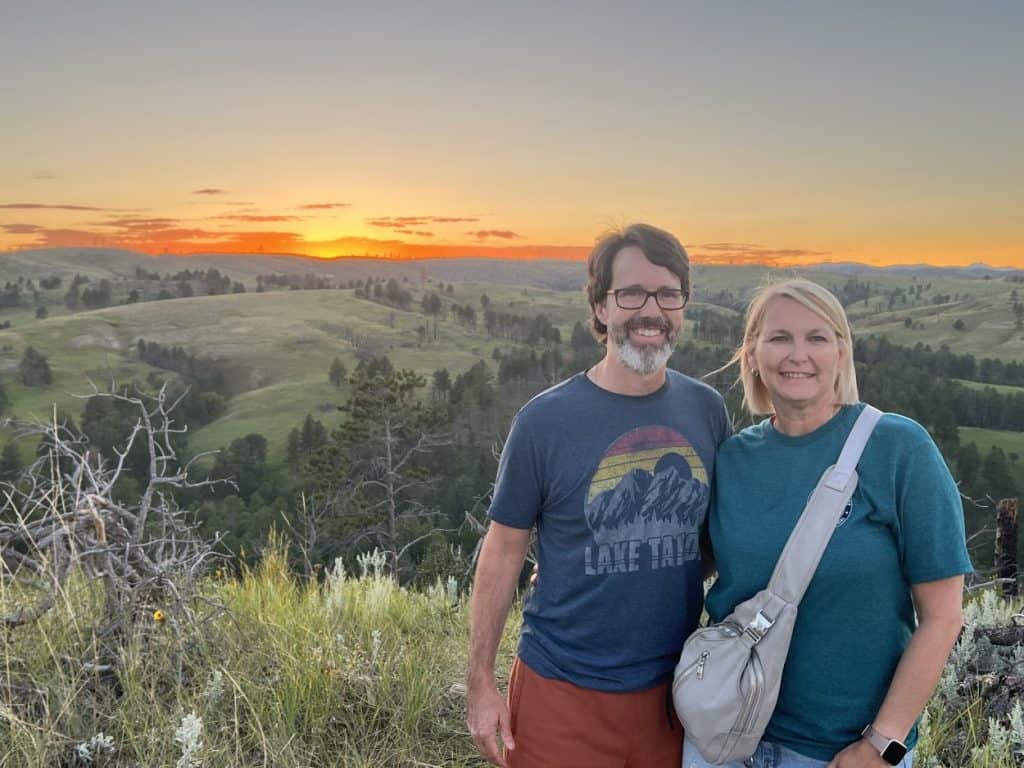
We suggest going to the park in the early morning to beat the crowds and improve your chances of wildlife sightings. By going early, Julie and I saw tons of wildlife and found few people on the roads and trails. The crowds increased noticeably from late morning through mid-afternoon.
Due to decreasing temperatures and crowds, evenings are also an excellent time to go. Animals become active again as the day comes to a close.
How Much Time Do You Need to See the Park?
If you aim to complete the park’s scenic drives, you can likely accomplish this in a few hours if you start early in the morning. A half day allows you to complete the scenic drives and take a short hike around the beautiful Sylvan Lake.
We recommend spending two to three days there to appreciate what the park offers. You will likely desire to take the scenic drives more than once. The extra time allows you to experience a few hikes and observe more wildlife. You can grab a meal or two at the park lodges and perhaps swim or paddle in one of the park’s lakes.
How Far is Mount Rushmore from Custer State Park?
The 17-mile drive north on Iron Mountain Road from Custer State Park’s East Entrance will lead you to Mount Rushmore.
Can You Visit Mount Rushmore and Custer State Park in One Day?
You can drive through Custer State Park and quickly stop at Mount Rushmore in one day. To experience more of what each park offers, we suggest a half-day in Mount Rushmore and at least one full day in Custer State Park.
Park Entrances
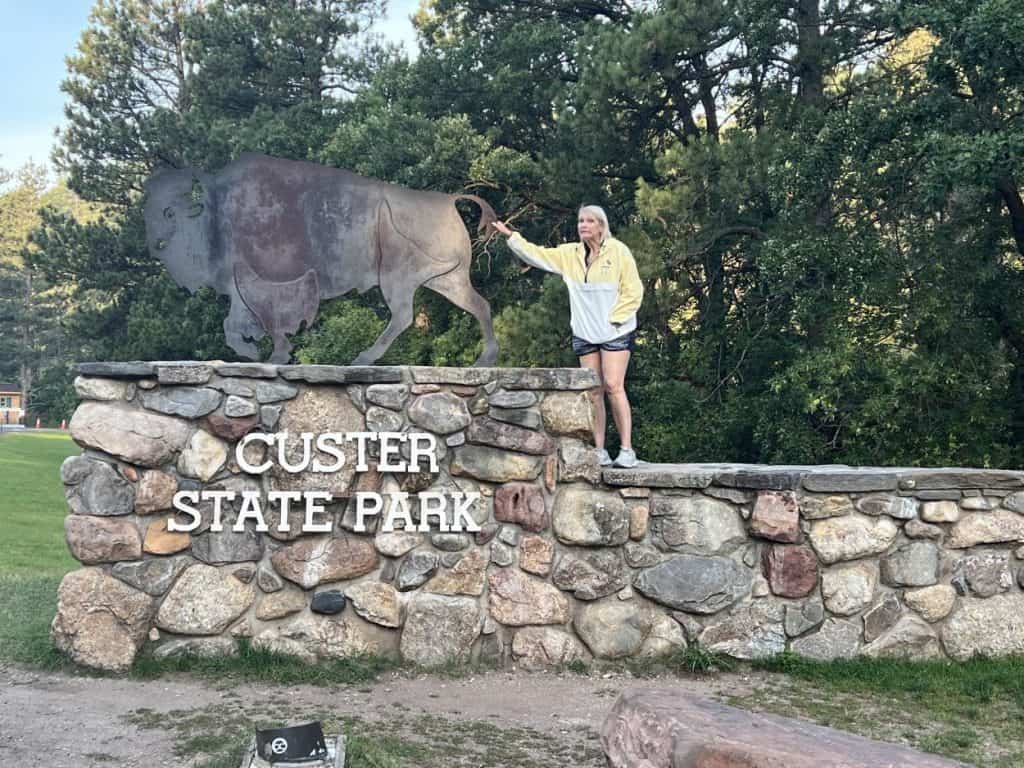
Custer State Park has four entrances.
East Entrance
The East Entrance is the park’s only entrance on the east side. Iron Mountain Road runs south from Mount Rushmore to the East Entrance.
Sylvan Lake Entrance
The Sylvan Lake Entrance nestles in the park’s northwest corner. It grants quick access to the alluring Sylvan Lake and the famous Needles Highway.
West Entrance
The West Entrance sits near the town of Custer and provides entry toward the middle of the park on the west side.
Blue Bell Entrance
The Blue Bell Entrance rests in the southwest region of the park and provides easy access to the famous Wildlife Loop Road.
Visitor Centers
Custer State Park houses six visitor centers.
Custer State Park Visitor Center
The park’s primary visitor center, Custer State Park Visitor Center, sits inside the East Entrance at the junction of Highway 16A and Wildlife Loop Road. It is an excellent place to start your adventure. You can obtain guidance from their helpful staff and learn more about bison. The visitor center houses a 100-seat theater where a 20-minute film plays every half hour.
Visitor Center Hours
- Memorial Day to Labor Day: Open 8 a.m. to 8 p.m.
- Labor Day through September: Open 8 a.m. to 6 p.m.
- October to Memorial Day: Open 9 a.m. to 4 p.m.
- Thanksgiving, Christmas, and Easter: Closed
Bison Center
The Bison Center rests on Wildlife Loop Road adjacent to the Buffalo Corrals. It tells the story of the park’s bison herd and educates guests on their importance through engaging displays. Custer State Park has a free-roaming herd of nearly 1,400 bison, one of the world’s largest publicly-owned bison herds.
Visitor Center Hours
- Memorial Day to Labor Day: Open 8 a.m. to 8 p.m.
- Labor Day through September: Open 9 a.m. to 6 p.m.
- October to November 5: Open 9 a.m. to 4 p.m.
- November 6 to Memorial Day: Closed
Wildlife Station Visitor Center
The Wildlife Station Visitor Center nestles on Wildlife Loop Road, 8 miles south of Highway 16A. Initially a herdsman’s house, the building was converted to a visitor center in 1987. In 2017, the park renovated the building to highlight the importance of the region’s mixed-grass prairies.
Visitor Center Hours
- Memorial Day to Labor Day: Open 8 a.m. to 6 p.m.
- Labor Day through September: Open 8 a.m. to 4 p.m.
- October to Memorial Day: Closed
Peter Norbeck Outdoor Education Center
The Peter Norbeck Outdoor Education Center sits near the State Game Lodge, one mile west of the Custer State Park Visitor Center on Highway 16A. Many of the park’s educational programs take place here.
Inside the building, kids can learn about the area’s unique ecosystems. The exterior is an outdoor classroom, encouraging unscripted play.
Visitor Center Hours
- Memorial Day through September: Open 9 a.m. to 5 p.m.
- October to Memorial Day: Closed
Badger Hole Historic Site
A cabin affectionately known as Badger Hole rests near Legion Lake, a half mile south of Highway 16A on Badger Clark Road. It was the home of Charles Badger Clark, South Dakota’s first poet laureate.
Visitor Center Hours
- Memorial Day through August: Open 10 a.m. to 5 p.m.
- September to Memorial Day: Closed
Gordon Stockade
The Gordon Stockade sits near the park’s West Entrance on Highway 16A. During the Black Hills Gold Rush, a group of gold seekers built a log fortress as protection from potential Lakota attacks.
The current building is the third replica constructed on the original site. It is now a historical landmark.
Visitor Center Hours
- Open year-round
Things To Do in Custer State Park
Custer State Park offers many ways to explore and enjoy its beautiful landscapes.
Scenic Drives

Housing rugged rock formations, fragrant pines, sprawling grasslands, and the potential to see unique wildlife around every bend, Custer State Park boasts some of the country’s best scenic drives.
Custer State Park’s scenic drives yielded so many picturesque landscapes and wildlife sightings that Julie and I repeated the circuit a few times during our visit.
Iron Mountain Road

Twisting and turning for 17 miles between Mount Rushmore and Custer State Park, Iron Mountain Road, also known as Highway 16A, proudly claims:
- 314 curves
- 14 switchbacks
- 4 presidents
- 3 pigtail bridges
- 3 tunnels
- 2 splits
Please do not let these numbers intimidate you. The drive is breathtaking. With a mix of grasslands, forests, and rugged mountains, you will not tire of the scenery.
Julie and I started the drive early morning, just after sunrise. On our first journey, we encountered at least fifty deer, a combination of white-tailed and mule deer. Drivers regularly spot other animals, including bison, bighorn sheep, mountain goats, pronghorns, and turkeys.
Yes, seeing so much wildlife is a thrill. However, please drive slowly and stay alert to your surroundings.
When driving north, the tunnels perfectly frame Mount Rushmore’s four presidents. The perspective is spectacular.
Before our South Dakota trip, I had not heard the term pigtail bridge. These corkscrew-shaped bridges wrap around a curve, allowing you to gain altitude quickly.
Wildlife Loop Road
The name says it all. Wildlife Loop Road is like a safari if you aim to see animals. It takes you through the park’s southern region, where you will discover vast prairies and hills dotted with pines.
We encountered more wildlife on the 18-mile stretch than any other national or state park. Going near sunrise or sunset should improve your odds dramatically. However, many animals inhabit the area, and sightings are possible at any time of day.
Along this stretch, we spotted bison, pronghorn antelope, prairie dogs, burros, deer, and wild turkeys. It was surreal.
Needles Highway

Highway 87, or the Needles Highway, runs from the Sylvan Lake Entrance to Legion Lake on the park’s western side. It features towering granite spires or needles. You will discover many pine and spruce along the jagged rock formations.
Wildlife sightings are standard on the 14-mile skinny road that comprises many curves, some sharp, others sweeping, and narrow tunnels. The Needles Eye rock formation sits outside its namesake tunnel, begging you to stop for a selfie.
We spotted deer and a couple of lone bison on Needles Highway. Locals advised us that mountain goats occasionally walk through the tunnels near sunrise and sunset. I can confirm that we spotted mountain goats above hiking trails near Needles Highway.
Needles Highway, Wildlife Loop Road, and Iron Mountain Road are worth your time. Each provides unique scenery and plenty of chances to see wildlife. We loved them all so much we drove each more than once.
Peter Norbeck National Scenic Byway
The Peter Norbeck National Scenic Byway comprises Highways 16A, 87, 89, and 244. The 70-mile picturesque route passes many iconic stops, including Crazy Horse Memorial, Custer State Park, Mount Rushmore, Black Elk National Wilderness Area, Norbeck Wildlife Preserve, and some of the best rocky peaks and forested hills of the Black Hills National Forest.
Driving Iron Mountain Road, Wildlife Loop Road, and Needles Highway allows you to see nearly all of Custer State Park and can be done as a continuous circuit. The Peter Norbeck National Scenic Byway adds alluring stretches to these roads, adding a sweet layer of icing to your proverbial cake.
Tunnel Information
People regularly ask about the tunnel dimensions. Here is what you need to know to ensure safe passage.
- Doane Robinson Tunnel on Iron Mountain Road is 12’ 0” wide and 11’ 4” high.
- C.C. Gideon Tunnel on Iron Mountain Road is 13’ 0” wide and 11’ 0” tall.
- Scovel Johnson Tunnel on Iron Mountain Road is 10’ 9” wide and 11’ 0” high.
- Hood Tunnel north of Sylvan Lake on Sylvan Lake Road is 8’ 9” wide and 9’ 8” tall.
- Needles Eye Tunnel on Needles Highway is 8’ 0” wide and 9’ 9” high.
- Iron Creek Tunnel on Needles Highway is 8’ 9” wide and 10’ 10” tall.
Wildlife Watching
Custer State Park is renowned for its wildlife. Whether you explore the park by hiking or scenic driving, you have realistic opportunities to observe animals in the wild. It makes an already great park thrilling.
Bison

Many travelers visit Badlands National Park and Custer State Park to see bison—the herd in Custer State Park numbers nearly 1,400. So, you have come to the right place.
Bison, often called buffalo, can reach 6.5 feet tall and weigh up to 2,000 pounds. Please do not let their size fool you. They are fast, capable of running 30 to 35 miles per hour.
Although we spotted a few bison along Needles Highway, we observed large herds driving Wildlife Loop Road. It is the best place in the park to see the massive creatures.
Bison Jam

Be prepared that you may get stuck in a bison jam. It happened to us a few times.
What is a bison jam? Essentially, traffic backs up with a long line of cars due to a herd of bison slowly crossing the road. On one occasion, we could not move for half an hour.
We experienced both fear and admiration during the bison jam. A giant bison rubbed up against our car on our first crossing. We were terrified that he was going to do an Incredible Hulk impression. Thankfully, he scratched his itch and moved on.
The bison jam allows you to observe the animals at close range for an extended time. Ironically, watching them graze and cross the street at their pace can be delightful.
Some glare at you, daring you to move. Others make noises, expressing their annoyance at your presence. Most could care less and go about business as usual. A few roll around in the grass, causing dirt and dust to spread across the prairie.
Occasionally, you see nurturing tendencies. We witnessed a large male sit along the edge of the road until all members crossed but a youngling. He then got up, walked to the middle of the road, and stopped to block the cars until the baby bison walked safely across. Once the little one crossed, he slowly meandered to join the herd. It was heartwarming.
We sincerely hope you experience a bison jam. It is an unforgettable experience.
Bighorn Sheep

Male bighorns or rams have thick, curled horns, while the females or ewes have smaller curved horns. Many visitors mistakenly think the ewes are mountain goats.
Unfortunately, we did not spot any rams on our visit. We did, however, observe many ewes and young bighorn sheep.
It is possible to spot bighorns along any of the three primary roads in the park. Herds are regularly spotted near French Creek and the Grace Coolidge Campground.
Scan open grassy areas as you drive. Bighorn sheep quietly graze and blend surprisingly well with the grasslands. At times, they feed near the road and suddenly cross without warning.
Driving near sunrise and sunset gives you the best odds of a sighting.
Pronghorns
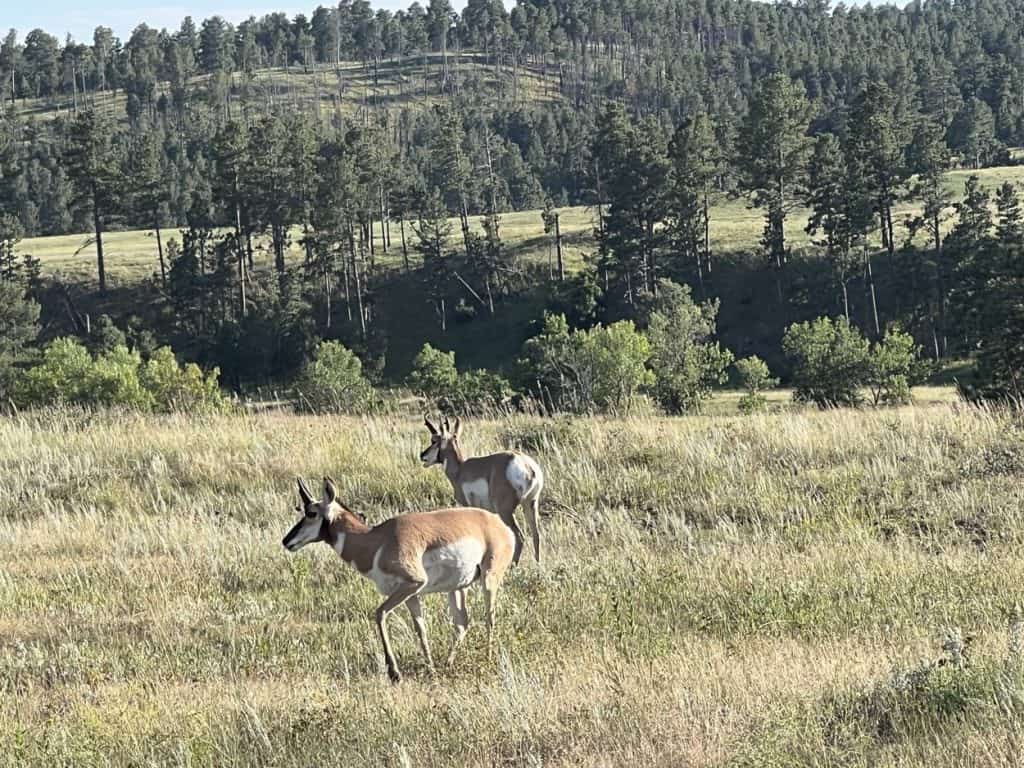
Commonly called antelope because they look similar, pronghorns inhabit the open prairies. Their name comes from the buck’s large pronged horns, which they shed yearly.
From a distance, they look like deer. As you get closer, you will see white splotches of fur and pronged horns.
The fastest land animal in North America, pronghorns, can reach up to 60 miles per hour. Two ran ahead of our car to cross the road before us.
We have greyhounds, so we are familiar with seeing fast animals. Their speed is impressive. However, you are more likely to see a pronghorn eating grass than running across the open prairie.
All of our pronghorn sightings occurred on Wildlife Loop Road. We had the most success near the start of Wildlife Loop Road on the park’s eastern side just after sunrise and before sunset.
Prairie Dogs

We expected to see prairie dogs in the Badlands but were caught off guard when we found them in Custer State Park. You can find the cute critters in the open grasslands along Wildlife Loop Road. Look for mounds of dirt in the prairies.
When you find the mounds, pull over for a closer look. You will discover black-tailed prairie dogs digging, scurrying, and barking calls to each other. Most of those barks are to warn the others about the scary humans along the prairie’s edge.
Mountain Goats
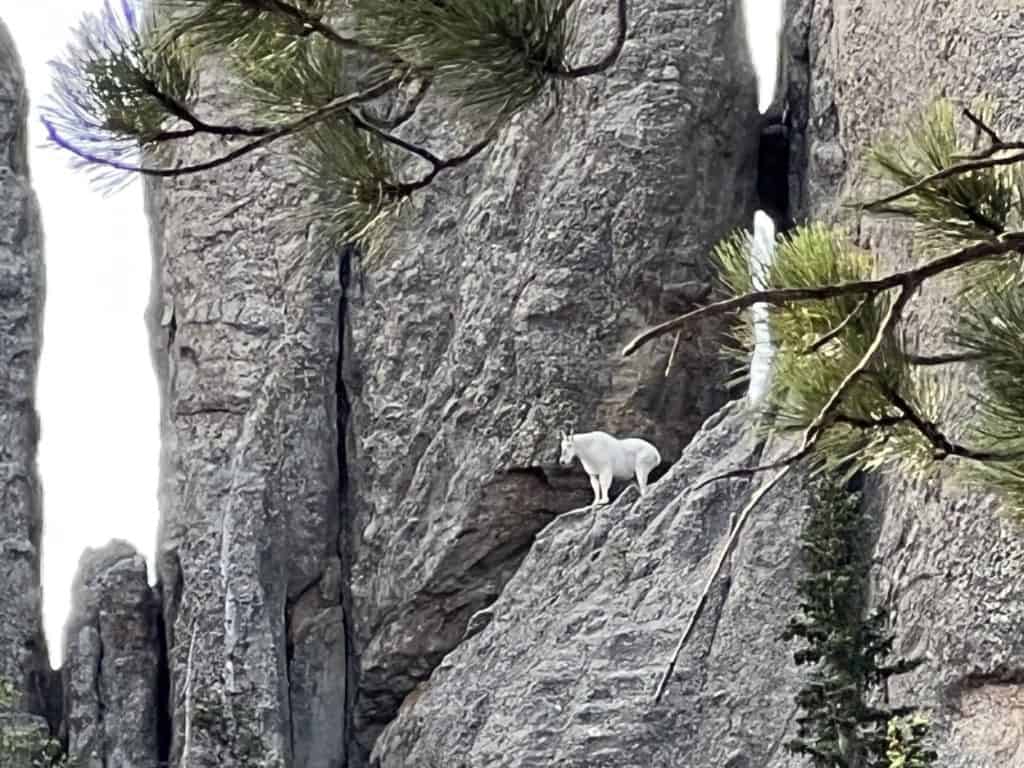
The magnificent snowy white mountain goats roam the higher elevations around Black Elk Peak. Accordingly, sightings can occur on Needles Highway.
We observed the beautiful animals while hiking Cathedral Spires in the early morning. The trailhead sits along Needles Highway.
We spotted one particular mountain goat watching us from above as we hiked. Be sure to look up at the jagged, rocky peaks occasionally. Otherwise, the mountain goats would be easy to miss.
I am fascinated by their sure footing along narrow ledges and envious of their disregard for heights. Seeing mountain goats during our hike was one of our trip highlights.
Begging Burros

Although not native to the area, Custer State Park has burros. The animals are descendants of a herd that once hauled visitors to the summit of Black Elk Peak. Custer State Park discontinued these rides years ago and released the donkeys into the park.
People affectionately call these funny animals begging burros because they walk to your car looking for food. Park rangers ask that you not feed them.
They will poke their heads into your car. If your window is rolled up, you will likely get a slobbery lick on the glass.
The begging burros are adorable. Julie fell in love with them as they surrounded our car, causing a burro jam.
We found the burros near the Bison Center on Wildlife Loop Road. Visitors also regularly spot them near the junction of Red Valley Road. Both areas sit at the southern end of Wildlife Loop Road.
Other Animals

Custer State Park houses many other animals, including coyotes, mountain lions, birds, elk, and deer. Driving through the park in the early morning or late evening, you will likely encounter many deer. The park has both white-tailed deer and mule deer. Drive with caution.
Coyote, mountain lion, and elk sightings are rare. Your best chances are near sunrise and sunset.
The park harbors various birds, including mountain bluebirds, golden eagles, prairie falcons, wild turkeys, and western tanagers. We spotted wild turkeys in the tall grass at the southern end of Wildlife Loop Road.
Hiking

With lakes, forests, mountains, and grasslands, Custer State Park offers many excellent hiking trails. Here are some of the most popular hiking options.
Sylvan Lake Shore Trail
The easy 1-mile loop takes you around Sylvan Lake. It sits near the Sylvan Lake Entrance, and you can access the path from any part of the lake. You will discover lovely reflections of jagged granite formations and trees as you walk the perimeter of the tranquil lake.
Badger Clark Trail
Located at Badger Hole, the trailhead is adjacent to the historic cabin. The moderate 1.2-mile loop snakes through forests of pines and hardwood trees and along rocky hillsides.
Little Devils Tower Trail
The Little Devils Tower Trail is 1.5 miles each way. With rock scrambling up cliffs, the last half mile is strenuous. However, the panoramic views from the summit are breathtaking, making the journey well worth the effort. Some consider the views the best in the park.
The trailhead sits on Needles Highway, less than one mile south of the Sylvan Lake General Store. You can also connect to this trail from the Cathedral Spires Trail.
Cathedral Spires Trail

The Cathedral Spires Trail is 1.5 miles each way. It is rated moderate to strenuous.
You will trek through the forest to a cathedral of soaring granite spires and unique rock formations. The trailhead rests south of Sylvan Lake on Needles Highway.
Julie and I love this hike. Within the first half mile, we saw a mountain goat, three woodpeckers, and a squirrel. The pines are fragrant, and the path has many pops of color, from yellow, purple, and white wildflowers. We found berries growing along the trail as well.
Near the trail’s end, we found another mountain goat watching us atop a narrow rocky ledge. With so much natural beauty and wildlife, it was sheer bliss.
We decided to take the trail junction for Little Devils Tower to extend our adventure. The rock scrambling was a challenge, but the resulting views at the summit more than made up for it.
Black Elk Peak Trail
Many consider the Black Elk Peak Trail Custer State Park’s premier hiking experience. You can take either Black Elk Peak Trail #4 (south of Sylvan Lake on Needles Highway) or Black Elk Peak Trail #9 (Sylvan Lake Day Use Area). Each is approximately 3.3 miles one way and is rated strenuous.
The trail ends at Black Elk Peak, previously called Harney Peak, the highest peak east of the Rocky Mountains in the United States. You can climb Harney Peak Fire Tower to savor the breathtaking view.
Swimming, Fishing, and Boating
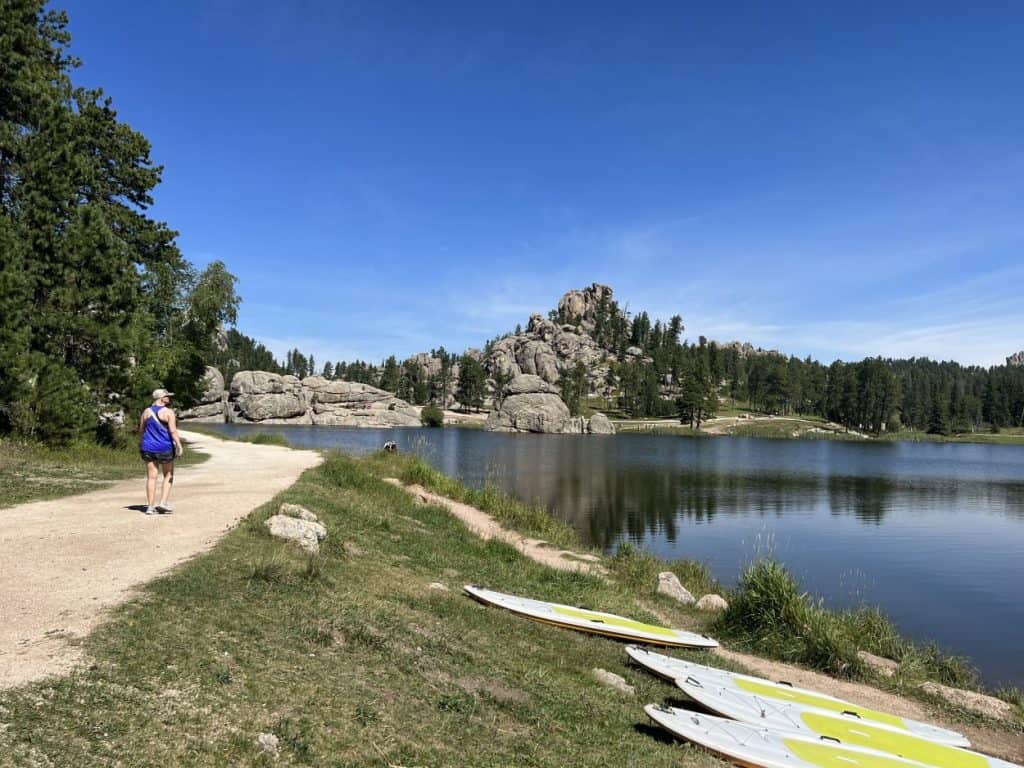
Custer State Park has five lakes:
- Center Lake
- Legion Lake
- Stockade Lake
- Sylvan Lake
- Game Lodge Pond
Please note Sylvan Lake is the park’s most famous lake and can get crowded. With a backdrop of alluring granite rocks, it is no wonder Sylvan Lake is one of the park’s most photographed spots.
Swimming
Guests may swim in all five of the park’s lakes. The park does not have lifeguards. Please note jumping into the water from cliffs and rocks is prohibited.
Fishing
Fishing is permitted anywhere in the park with a valid state fishing license. Rainbow, brook, and brown trout inhabit the park’s waters. Stockade Lake contains bass, northern pike, perch, crappie, bluegill, and bullhead.
Boating
Boating is allowed on Center, Legion, Stockade, and Sylvan Lakes. You can rent canoes, kayaks, and stand-up paddle boards at Legion Lake and Sylvan Lake.
Buffalo Roundup
Each year in late September, Custer State Park holds its Buffalo Roundup. It takes place near the corrals on Wildlife Loop Road. The event lasts three days and includes music, entertainment, food, and over 100 arts and crafts booths.
What is the purpose of the roundup? The park’s grasslands can support about 1,400 bison. All bison get corralled, checked for diseases, and vaccinated. The park then sells the surplus at an auction.
Where To Stay
You have several solid accommodation options in and around Custer State Park.
Camping
Custer State Park offers campsites, cabins, and primitive camping. You can make reservations one year in advance. Please visit the camping site to verify rates and availability.
Lodges
The park has four resorts:
- State Game Lodge
- Legion Lake Lodge
- Blue Bell Lodge
- Sylvan Lake Lodge
Each lodge offers a cabin-like escape by a meadow, forest, or lake. State Game Lodge nestles near the Custer State Park Visitor Center. Legion Lake Lodge rests along its namesake lake between the park’s East and West Entrances.
Blue Bell Lodge is near the Blue Bell Entrance and the start of Wildlife Loop Road in the park’s southwestern region. Sylvan Lake Lodge sits near its namesake lake and entrance in the park’s northwest corner.
Outside the Park
Julie and I stayed at two unique places, each conveniently located near Mount Rushmore National Memorial and Custer State Park. In full disclosure, Kampgrounds of America (KOA) hosted us for part of our stay. We stayed two extra nights at a vacation rental through VRBO. All opinions are our own.
Although each place is different, we highly recommend both. Your circumstances will determine which best suits your needs.
Mount Rushmore KOA Resort at Palmer Gulch
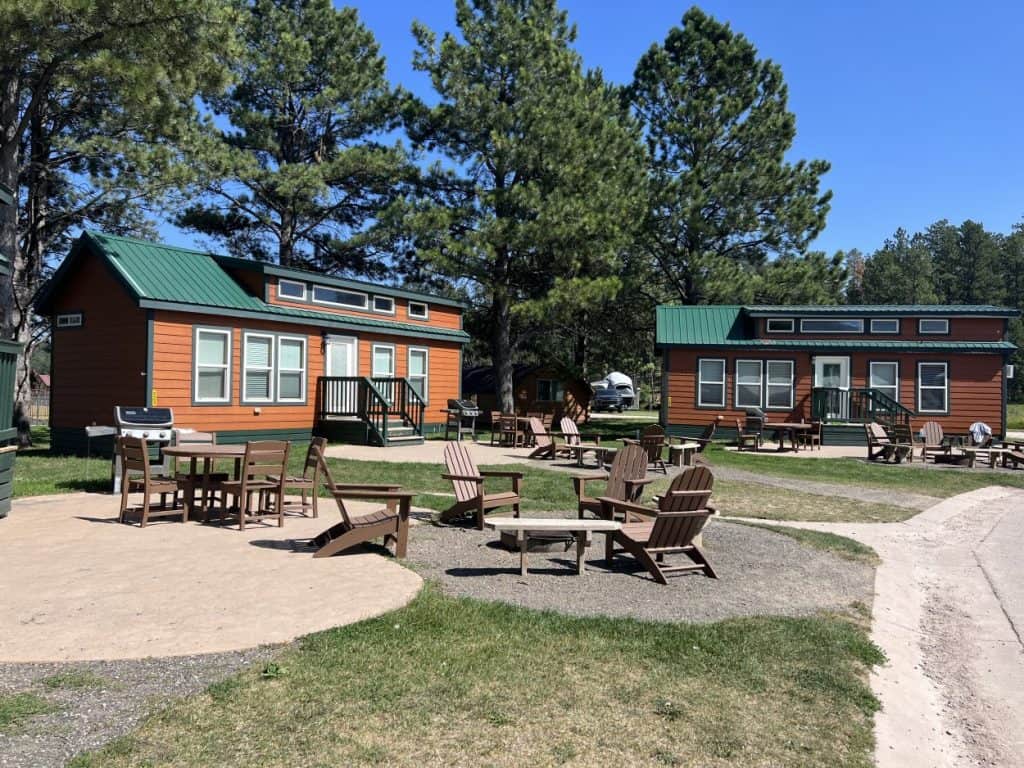
If you like camping, KOA offers a top-notch experience at their Mount Rushmore KOA Resort at Palmer Gulch. It has nearly too many amenities to count, many catering to families with children.
The campground has tent sites, RV sites, and cabins. We stayed in a deluxe cabin with two bedrooms, an upstairs sleeping loft, a full kitchen, and a shower. Outside the house, we had a firepit and chairs. It was the perfect glamping experience.
The campground has restaurants, shops, golf cart rentals, a swimming pool, biking, horseback riding, fishing, mini-golf, a chuckwagon supper, and a rodeo. You will also find plenty of food options on campus.
You could stay in the campground all week and never get bored or hungry. However, you can quickly drive from here to Mount Rushmore and Custer State Park. KOA has elevated the camping experience at Palmer Gulch.
VRBO – Mount Rushmore View

If you prefer privacy, stay at the Mount Rushmore View through VRBO. The fabulous vacation rental has a rustic vibe with sliding barn doors and Western decor, but it is spotless and has everything you need. Although cozy, it feels spacious.
The comfortable deck provides a window through the surrounding fragrant pines, where you can see the presidents carved into Mount Rushmore. It is spectacular and the perfect place to unwind after exploring.
You can watch the monument get illuminated on the horizon at nightfall. The deck yields excellent stargazing opportunities as stars spark to life in the night sky.
You can prepare a lovely meal and enjoy the deck and house with a full kitchen. The view from the deck by itself is enough reason to stay here. However, the excellent home and beautiful setting of soaring pines and rugged granite mountains enhance the experience further.
The hosts are some of the nicest people we have encountered on our travels, ensuring you have a wonderful stay.
Where To Eat
Each of the Custer State Park lodges has its own restaurant. Julie and I ate at the Blue Bell Lodge and the Dockside Grill at Lake Legion. Both are excellent.
The Blue Bell Lodge delivers a cabin ambiance and hearty food, while the Dockside Grill feels a bit more upscale with a lakeside view and tasty fare.
Outside the park in the town of Custer is a fun eatery called Purple Pie Place. The purple house serves up mouthwatering pies and ice cream. You can also order salads, soups, sandwiches, paninis, chicken pot pie, and mac & cheese.
The famous place regularly sees people lined up to taste their delicious pies. We enjoyed it so much we each ordered a second slice to go.
Things To Do Near Custer State Park
With many iconic places and natural wonders, South Dakota’s Black Hills region provides a perfect opportunity to see multiple bucket list destinations in one trip.
Mount Rushmore National Memorial
The 17-mile scenic drive along Iron Mountain Road connects two of the area’s primary attractions, Custer State Park and Mount Rushmore. As you drive north toward the memorial, narrow tunnels yield a framed view of Mount Rushmore. Guests regularly spot wildlife on the winding road. A Mount Rushmore visit gives you a greater appreciation for the monument and rekindles your patriotic spirit.
Crazy Horse Memorial
The Crazy Horse Memorial sits about 45 minutes northwest of Custer State Park. Although the memorial is under construction, you can see the progress and learn more about Crazy Horse and the region’s Native American people.
Badlands National Park
Outside the Black Hills, Badlands National Park sits about 1.5 hours east of Custer State Park. The park showcases striped mounds and canyons between sprawling mixed-grass prairies. Guests regularly observe bison, prairie dogs, and bighorn sheep while driving or hiking in the park.
Wind Cave National Park
A giant underground world rests a half hour south of Custer State Park. Above ground, visitors can hike over 30 miles of trails through grasslands and ponderosa pines. Below the surface, rangers provide guided tours of the cave and its beautiful rock formations. Visit the Wind Cave National Park site to verify tour availability.
Jewel Cave National Monument
The Jewel Cave National Monument is 45 minutes west of Custer State Park. It contains over 215 miles of mapped passages, making it one of the world’s longest caves. Guests must take a guided tour to explore the cave. Park rangers suggest you make reservations to secure your spot.
Wrap-Up: Custer State Park
Mount Rushmore may obscure Custer State Park in its shadow, but the fantastic state park delivers the goods. If you enjoy scenic drives, rewarding hikes, or wildlife watching, add Custer State Park to your South Dakota vacation plans. Bison, granite spires, and breathtaking views will leave you with memories for a lifetime.
Featured image credit: Miles with McConkey

